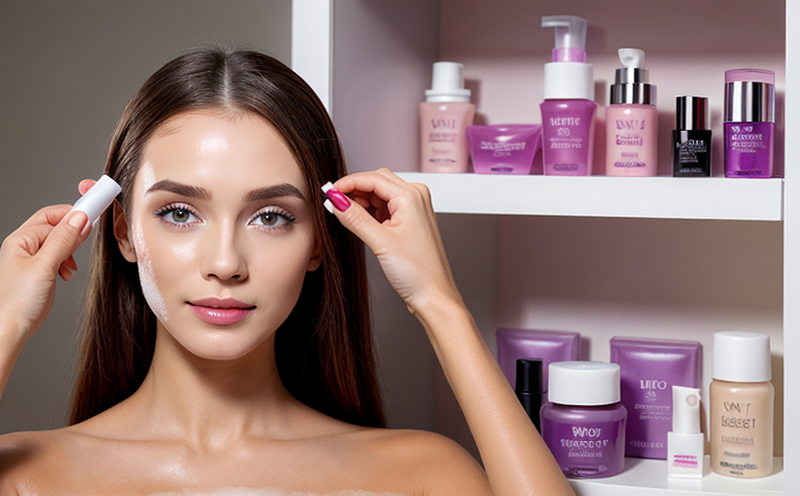Consumer Sensory Panel Testing of Cosmetics
The consumer sensory panel testing service is a critical component in the quality assurance and product safety processes for cosmetics and personal care products. This method leverages trained human testers to evaluate the sensory attributes of cosmetic formulations, providing insights into their appearance, smell, taste, texture, and overall user experience.
Consumer sensory panels are essential for brands aiming to meet regulatory standards while ensuring that their products meet consumer expectations. The process involves a series of structured tests designed to identify potential issues early in the product development lifecycle or before commercial launch. This ensures that the final product is safe, effective, and meets both legal requirements and market demands.
The sensory panelists undergo rigorous training to ensure they can consistently provide accurate and reliable feedback. This training includes understanding the specific attributes being tested for each product category and learning how to communicate these observations clearly and objectively. The trained sensory panelists then evaluate the products using standardized protocols, which often include quantitative scoring systems.
One of the key aspects of consumer sensory panel testing is its ability to detect subtle differences in formulation that may not be apparent through instrumental analysis alone. This makes it particularly valuable for brands looking to differentiate their products from competitors by improving texture, color, or scent profiles. By incorporating consumer feedback early on, companies can refine formulations and enhance product appeal before investing heavily in manufacturing and marketing.
Furthermore, sensory panel testing plays a crucial role in ensuring compliance with international regulations such as those outlined in the EU Cosmetics Regulation (EC 1223/2009), which mandates that all cosmetic products sold within the European Union must comply with strict safety requirements. Similarly, the FDA’s Good Manufacturing Practices (GMP) guidelines emphasize the importance of sensory evaluation in assessing product quality and safety.
Another important aspect is the role of consumer sensory panel testing in supporting the development of new formulations. By involving real consumers early in the process, companies can gather valuable insights into how different ingredients or processing methods affect the overall perception of a product. This information helps guide formulation adjustments that could lead to better acceptance among target demographics.
In summary, consumer sensory panel testing is an integral part of modern cosmetic development and quality assurance processes. It provides essential data on sensory attributes which can significantly influence consumer preference and satisfaction. By leveraging trained human testers, companies gain deeper understanding into what consumers want from their beauty products – information that translates directly into improved product performance.
Scope and Methodology
The scope of consumer sensory panel testing covers a wide range of cosmetic and personal care items such as skincare creams, lotions, makeup foundations, shampoos, conditioners, deodorants, perfumes, and more. Each test is tailored to the specific attributes relevant to each product type.
- Appearance: Evaluating color consistency, clarity, opacity, and any visual defects like streaks or unevenness.
- Scent: Assessing fragrance strength, balance, longevity, and whether it aligns with the expected profile of the product.
- Taste: In some cases where ingestible products are involved (e.g., lip balms), this attribute is also evaluated for safety concerns.
- Texture: Determining smoothness, spreadability, adherence, and overall tactile experience when applied to skin or hair.
The methodology involves several stages starting from the preparation of samples according to standard procedures. This includes homogenizing ingredients uniformly if necessary, adjusting temperatures where appropriate, and ensuring consistent application techniques across all testers.
Panelists follow detailed instructions provided by trained personnel who oversee each session. They record their observations meticulously using predefined scales or checklists designed specifically for the attributes being tested. These records serve as crucial reference points during analysis phases to identify trends or outliers that warrant further investigation.
Industry Applications
The application of consumer sensory panel testing extends beyond just cosmetic product development; it also supports various other aspects within the broader beauty industry. For instance, in formulation research and development (R&D), this service helps identify optimal combinations of raw materials that enhance efficacy while maintaining safety standards.
In manufacturing, sensory panels ensure consistency across batches produced at different facilities or during transitions between suppliers. This is particularly important for batch sizes where slight variations can significantly impact customer experience post-purchase.
For marketing strategies, understanding consumer preferences through sensory evaluations provides valuable input into packaging design, advertising campaigns, and promotional materials. It informs decisions about which features to highlight based on what consumers value most highly in similar products.
Additionally, regulatory compliance remains a significant driver for incorporating consumer sensory panel testing into business practices. Meeting stringent requirements set by agencies like the FDA or EU Cosmetics Regulation ensures smooth market entry and avoids potential legal challenges later down the line.
International Acceptance and Recognition
- ISO/IEC: International Organization for Standardization (ISO) and International Electrotechnical Commission (IEC) have established guidelines on sensory evaluation practices which are widely adopted globally.
- ASTM: ASTM International provides standards related to consumer product safety, including those applicable specifically to cosmetics. These standards help standardize testing procedures internationally.
- EN: European Norms (EN) cover various aspects of cosmetic formulation and packaging design, reflecting the stringent requirements set by EU regulations.
The acceptance of consumer sensory panel results varies across regions but generally follows established protocols. In most countries where there are no local prohibitions against human-based testing methods, sensory panels are recognized as valid means of assessing product attributes. However, it is crucial for companies to ensure they comply with all relevant laws and regulations in each jurisdiction they operate within.





